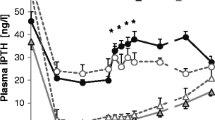Summary
In previous studies we have demonstrated a natriuretic factor of small molecular weight (<1,000 Daltons) in the serum and urine of salt loaded subjects. This factor isolated from salt loaded animals inhibits the Na-K-ATPase enzyme system. In addition, the natriuretic material isolated from plasma of salt-loaded dogs was shown to bind to specific digoxin antibodies. It was therefore suggested that a digitalis-like endogenous natriuretic factor (endoxin) is released in response to saline loading. In the present study we therefore investigated the presence of such an endogenous natriuretic digitalis-like activity in the urine of healthy volunteers during high salt intake. Using Sephadex G-25 for chromatographic separation of urine a material elutes as a single peak in the natriuretic post-salt fraction IV which is specifically bound to digoxin antiserum complex. Mean peak activity amounted to 1.55±0.48 ng/ml digoxin equivalents. We further purified the natriuretic material by immunoprecipitation with the digoxin antiserum complex. This purification procedure resulted in a more than 10-fold increase in specific natriuretic activity from 2.7±0.4 to 30.4±5.8 µEq Na+·min−1·mg−1. Thus the digitalis-like natriuretic activity previously observed in the plasma of saline loaded dogs is also present in the urine of healthy subjects during high dietary salt intake. Immunoprecipitation may offer a meaningfull tool for further isolation and identification of the natriuretic hormone(s).
Zusammenfassung
In früheren Untersuchungen haben wir einen kleinmolekularen (<1000 Dalton) natriuretischen Faktor in Serum und Urin von Kochsalz-belasteten, gesunden Versuchspersonen nachgewiesen. Dieser Faktor hemmt das Na-K-ATPase Enzymsystem. Kürzlich wurde gezeigt, daß eine natriuretische Aktivität, isoliert aus dem Plasma Kochsalz-belasteter Hunde, spezifisch von Digoxin-Antikörpern gebunden wird. Es wurde daher postuliert, daß Kochsalzbelastung die Freisetzung eines Digitalis-ähnlichen endogenen natriuretischen Faktors (Endoxin) stimuliert. Wir untersuchten daher in der vorliegenden Arbeit die Existenz eines solchen Digoxin-ähnlichen Faktors im Urin gesunder, Kochsalz-belasteter Probanden. Der Urin wurde an Sephadex G-25 chromatographiert. Dabei eluierte in der natriuretischen Fraktion IV ein Material, das von einem Digoxin-Antiserum-Komplex gebunden wird, in einem einzigen Gipfel. Die maximale Aktivität in Fraktion IV betrug 1,55±0,48 ng/ml Digoxin-Äquivalente. Durch Reinigung des natriuretischen Materials mittels Immunpräzipitation mit dem Digoxin-Antiserum-Komplex wurde eine mehr als 10fache Steigerung der spezifischen natriuretischen Aktivität im Mittel von 2,7±0,4 auf 30,4±5,8 µÄq Na+ min−1·mg−1 erreicht. Die zunächst im Plasma Kochsalz-belasteter Hunde beobachtete Digitalis-ähnliche natriuretische Aktivität ist somit auch im Urin gesunder Kochsalz-belasteter Probanden nachweisbar. Immunpräzipitation könnte ein hilfreicher Schritt bei der Isolierung des natriuretischen Hormons sein.
Similar content being viewed by others
References
Gonick HC, Kramer HJ, Paul W, Lu E (1977) Circulating inhibitor of sodium-potassium-activated adenosine triphosphatase after expansion of extracellular fluid volume in rats. Clin Sci Mol Med 53:329–334
Gruber KA, Whitaker JM, Buckalew VM jr (1980) Endogenous digitalis-like substance in plasma of volume-expanded dogs. Nature 287:743–745
Kramer HJ, Gonick HC, Paul W, Lu E (1969) Third factor: Inhibitor of Na-K-ATPase? Presented at the IVth Int. Congr. Nephrology Abstracts I (free Communication), p 373
Kramer HJ (1971) Humoraler Inhibitor des aktiven Natrium-Transports im Plasma Volumen-expandierter Ratten. In Heinz R, Holzhüter H (eds) Proceedings VIII. Symposion der Gesellschaft für Nephrologie, Aachen, pp 519–526
Kramer HJ, Gonick HC, Krück F (1972) Natriuretisches Hormon. Klin Wochenschr 50:893–897
Kramer HJ (1974) Untersuchungen zur Existenz eines Natriuretischen Hormons und dessen möglichem Wirkungsmechanismus. Ann Univ Sarav (Med) 21:140–193
Kramer HJ, Gonick HC (1974) Effect of extracellular volume expansion on renal Na-K-ATPase and cell metabolism. Nephron 12:281–296
Kramer HJ, Gospodinov B, Krück F (1974) Humorale Hemmung des epithelialen Natrium-Transportes nach akuter Expansion des Extracellularvolumens: Weitere Untersuchungen zur Existenz eines natriuretischen Hormons. Klin Wochenschr 52:801–808
Kramer HJ (1975) Natriuretic hormone — its possible role in fluid and electrolyte disturbances in chronic liver disease. Post-grad Med J 51:532–540
Kramer HJ (1976) Natriuretic activity in plasma following extracellular volume expansion. In: Kaufmann W, Krause DK (eds) Central nervous system control of Na+ balance — relations to the renin-angiotensin system. Thieme, Stuttgart, pp 126–133
Kramer HJ, Bäcker A, Krück F (1977) Antinatriferic activity in human plasma following acute and chronic salt loading. Kidney Int 12:214–222
Kramer HJ (1978) Antinatriferic and natriuretic activities in human plasma following acute and chronic salt-loading. In: Kramer HJ, Krück F (eds) Natriuretic hormone. Springer, Berlin Heidelberg New York, pp 24–33
Kramer HJ, Rietzel C, Klingmüller D, Düsing R (1980) Further studies on isolation and purification of a small molecular weight natriuretic hormone. In: Lichardus B, Schrier RW, Ponec J (eds) Hormonal regulation of sodium excretion. Elsevier/North-Holland, Amsterdam New York Oxford, pp 313–322
Raghavan RRV, Gonick HC (1980) Partial purification and characterization of natriuretic factor from rat kidney. Proc Soc Exp Biol Med 164:101–104
Schreiber V, Kölbel F, Stepan J, Gregorova I, Pribyl T (1981) Digoxin-like immunoreactivity in the serum of rats with cardiac overload. J Mol Cell Cardiology 13:107–110
Skou JC (1965) Enzymatic basis for active transport of Na and K across cell membranes. Physiol Rev 45:586–617
Sonnenberg H, Cupples WA, DeBold AJ, Veress AT (1981) Intrarenal localization of the natriuretic effect of cardiac atrial extract. In: Scott WN, Goodman DBP (eds) Hormonal regulation of epithelial transport of ions and water. The New York Academy of Sciences, New York, pp 213–214
Ussing HH, Zerahn K (1951) Active transport of sodium as the source of electric current in the short-circuited isolated frog skin. Acta Physiol Scand 23:110–127
Author information
Authors and Affiliations
Additional information
Dedicated to Professor F. Krück on the occasion of his 60th birthday
This study was supported in part by grant No. FA-8871, Ministerium für Wissenschaft und Forschung NRW, FRG
Rights and permissions
About this article
Cite this article
Klingmüller, D., Weiler, E. & Kramer, H.J. Digoxin-like natriuretic activity in the urine of salt loaded healthy subjects. Klin Wochenschr 60, 1249–1253 (1982). https://doi.org/10.1007/BF01716732
Issue Date:
DOI: https://doi.org/10.1007/BF01716732




